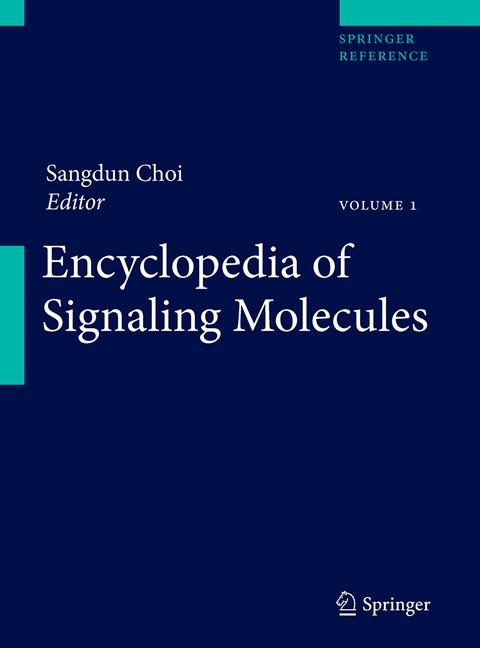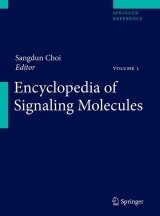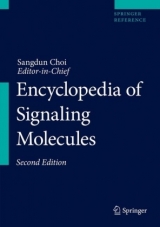Encyclopedia of Signaling Molecules
Springer-Verlag New York Inc.
978-1-4419-0460-7 (ISBN)
- Titel erscheint in neuer Auflage
- Artikel merken
Biological processes are driven by complex systems of functionally interacting signaling molecules. Thus, understanding signaling molecules is essential to explain normal or pathological biological phenomena. A large body of clinical and experimental data has been accumulated over these years, albeit in fragmented state. Hence, systems biological approaches concomitant with the understanding of each molecule are ideal to delineate signaling networks/pathways involved in the biologically important processes. The control of these signaling pathways will enrich our healthier life. Currently, there are more than 30,000 genes in human genome. However, not all the proteins encoded by these genes work equally in order to maintain homeostasis. Understanding the important signaling molecules as completely as possible will significantly improve our research-based teaching and scientific capabilities. This encyclopedia presents 350 biologically important signaling molecules and the content is built on the core concepts of their functions along with early findings written by some of the world's foremost experts. The molecules are described by recognized leaders in each molecule.
The interactions of these single molecules in signal transduction networks will also be explored. This encyclopedia marks a new era in overview of current cellular signaling molecules for the specialist and the interested non-specialist alike During past years, there were multiple databases to gather this information briefly and very partially. Amidst the excitement of these findings, one of the great scientific tasks of the coming century is to bring all the useful information into a place. Such an approach is arduous but at the end will infuse the lacunas and considerably be a streamline in the understanding of vibrant signaling networks. Based on this easy-approach, we can build up more complicated biological systems.
5-Hydrocytryptamine receptor 3a.- 5-Hydroxytryptamine receptor 2B.- 5-Hydroxytryptamine receptor 2C.- A-Raf.- ABCA.- Ack1.- ADAP.- Adap1.- Adenylyl cyclase.- Adenylyl cyclase type 9.- Adhesion-GPCRs.- ADP-ribosylation factor domain protein 1.- Ags (Activators of G-protein signaling).- Aif.- AKAP.- Androgen receptor.- Angiotensin II receptor 2.- Ant.- AP-3.- AP-4.- Apo2L (TRAIL).- Arap3.- Arf-like protein 8b.- Arfgap1.- Arfrp1.- ATF3.- Aurora kinase.- Bcl2 family.- Beta-Catenin.- Bradykinin receptor.- Btg/Tob.- c-Myb.- Cadherin.- Calcium channel, voltage-dependent.- Calpain.- Carma1.- Casein kinase II.- Caspase.- Cbln1.- CCL3 [chemokine (C-C motif) ligand 3].- CCL4 [chemokine (C-C motif) ligand 4].- CCL5 [chemokine (C-C motif) ligand 5].- CCN.- CCTa.- CD160.- CD3.- CD3 zeta.- CD38.- CD40.- CD43.- CD45.- CD47.- CD53.- CD72.- CD81.- CD91.- Cdc7.- CDK11.- Ceacam.- Chemokine ligand CX3CL1.- Chemokine receptor CCR1.- Cholecystokinin type B receptor (CCK type B receptor).- Cholecystokinin-1 receptor.- CKIP-1.- CLEC-1.- CLEC-2.- CLEC4E.- CLEC5A.- Clk.- Copine.- CREB.- Csk.- Csk homologous kinase.- CXCL10 [Chemokine (C-X-C motif) ligand 10 or IP-10].- Cyclin A.- Dap kinase.- Darpp.- Dbf4.- Dect in-1.- delta glutamate receptor.- DHHC.- DLK (dual leucine zipper-bearing kinase).- Dock2.- Drak2.- Ect2 (epithelial cell transforming 2 oncogene).- eIF5.- eIF6.- Endo180.- Endothelin A receptor.- Eph receptor.- EphA3.- Eps8 (epidermal growth factor receptor pathway substrate 8).- Erk1/Erk2.- Erk3/Erk4.- ERK5/MEK5.- Estrogen receptor.- Fbln.- FGF (fibroblast growth factor).- Fgr.- Fhit.- Flotillin 1.- Flotillin 2.- Fn14.- Follicle stimulating hormone receptor.- Formyl peptide receptor.- FOXO1.- FPR2/ALX.- Frabin.- Frs2.- FZD (frizzled homolog).- G alpha i-class G protein alpha subunits.- G protein alpha 12.- G protein alpha q.- G protein alpha transducin.- G protein beta/gamma.- Gab1.- Gab2.- GABA A receptor.- Gadd45.- Galanin receptor.- Gat (GABA transporter).- GATA-3 (GATA binding protein 3).- GCAP (guanylyl cyclase activating protein).- Geft.- Glucose dependent insulinotropic polypeptide receptor.- Glutamate receptors.- Gpr84.- Grp94 (HSP90B1).- Gsk (glycogen synthase kinase).- GST (glutathione S-transferase).- Guanylate cyclase.- Guanylyl cyclase C.- Guanylyl cyclase receptors.- HB-EGF (heparin-binding EGF-like growth factor).- Hipk2.- Hippocalcin.- hnRNP (heterogeneous nuclear ribonucleoprotein).- Homer.- Hpk1.- IAP.- Icmt (Isoprenylcysteine carboxyl methyltransferase).- Id4 (Inhibitor of DNA binding 4).- IFN gamma.- IGF1R (insulin-like growth factor 1 receptor).- IL6.- IL7.- Inositol 1,4,5-triphosphate-associated cGMP kinase substrate.- Integrin alpha 1.- Integrin alpha 11.- Integrin alpha 2.- Integrin alpha 4.- Integrin alpha E.- Integrin alpha V.- IP3 receptor.- IRF5.- IRG (immunity-related GTPase).- Itpk1 (inositol 1,3,4-triphosphate 5/6 kinase).- Itsn.- Laforin.- Lat (linker for activation of T cells).- LCoR.- LIMK.- Lysyl oxidase.- MAIL (IkBz).- Malt1 (mucosa associated lymphoid tissue lymphoma translocation gene 1).- MAP kinases (comprising 14 genes: Erk1, Erk2, Erk3, Erk4, Erk5, Erk7, Jnks (3 isoforms), p38 (4 isoforms) and Nlk).- Mapkap kinase 2/3 (MK2/3).- Mapkap kinase 5 (MK5)(PRAK).- Mark (MAP/microtubule affinity-regulating kinase).- Mek.- Mek3.- Mk-styx.- MKK6.- Mlk (mixed lineage kinase).- MLTK.- MORF/MOZ lysine acetyltranferase.- Mps1.- Msk1.- mTOR.- Mtus1.- Myc.- MyD88 (myeloid differentiation primary response gene 88).- MYLK (Myosin linght chain kinase).- Myosin I (Myo1).- Myosin III.- Myosin X.- N-WASP.- Ncam (neural cell adhesion molecule).- Nek (never in mitosis gene a-related expressed kinase).- Net1 (neuroepithelial cell transforming gene 1 protein).- Neurotensin receptor.- NF-kB family.- NFAT.- Nherf.- NK receptor.- NKG2D.- NKp46.- NMT (N-myristoyltransferase).- Notch.- Nrf2 (NF-E2-related factor2).- nrip1(Nuclear Receptor-Interacting Protein 1).- NTPDase family.- Nucleotide receptor P2x.- Nucleotide receptor P2y.- Olfactory receptor.- Opioid receptor.- P-Rex.- p130Cas.- P2Y14 receptor.- P38 MAPK.- P53.- Pak2.- PCAF lysine acetyltransferase.- Pea15.- Phlda1 (T-cell death associated gene)(Pleckstrin homology-like domain, family A, member 1).- Phosphodiesterase 1.- Phosphodiesterase 10A.- Phosphodiesterase 4, cAMP specific.- Phosphoinositide 3-kinase.- Phosphoinositide 5-phosphate 4-kinase.- Phospholipase A.- Phospholipase D.- Pim-1.- Pin1 (peptidylprolyl cis/trans isomerase, NIMA-interacting 1).- Pink1.- PKD.- PKR.- Plasma membrane calcium transporting ATPase.- Plekhg5.- Polycystin.- PP2C.- Prep.- Prion protein.- Protein farnesyltransferase.- Psgr (prostate specific G-protein coupled receptor).- PTEN.- PTK6.- PTPe (RPTPe and cyt-PTPe).- PTPN3/PTPN4.- R7BP/R9AP.- Rab18.- Rab23.- Rab 7.- Rab 8.- Rac.- Raf1.- Ramp.- Ran.- RANKL and RANK.- Rap GEF family.- Ras (H-, K-, N-Ras).- RASA1.- Rasgrf (RAS protein-specific guanine nucleotide-releasing factor).- RasGRP1.- Rcan1 (regulator of calcineurin).- Recoverin.- Relaxin family peptide receptor: 1 & 2.- Relaxin family peptide receptor: 3 & 4.- Retinoic acid receptor.- RGS family.- Rgs13.- RhoC.- Rhodopsin kinase.- Ric8.- Rin (Ras-like protein in neuron).- RIN family proteins (RIN1, RIN2 and RIN3).- ROCK kinases.- Rpn8.- Rpt.- Rrad (Ras-related associated with diabetes).- Rsk (p90 ribosomal S6 kinase).- RyR (ryanodine receptor).- S100 Proteins.- SAMSN1 (SAM domain, SH3 domain and nuclear localization signal).- SARA.- Sh2d2a (SH2 domain protein 2A).- SHIP.- SHP-1.- SKAP-HOM.- Slp (synaptotagmin-like protein).- SLP-76 (SH2 domain containing leukocyte protein of 76kDa).- SOCS.- Somatostatin receptor.- Sonic hedgehog.- Sphingosine-1-phosphate.- Src.- Sry.- STAT.- Striatal-Enriched Protein Tyrosine Phosphatase (STEP).- Sulfiredoxin.- SWI/SNF (SWItch/Sucrose NonFermentable).- TBCCD1.- Tead.- The Steroid Receptor Coactivator Family.- Thrombospondin 1.- TLR adaptor protein.- TLR3.- TLR4.- TLR5.- TLR9.- TMEM85 (transmembrane protein 85).- TPD52 (tumor protein D52).- Tpl2.- TRAF6.- TRAIL receptor 1/2 (death receptor 4/5, DR4/5).- Trb (tribbles).- Trp (transient receptor potential cation channel).- Urokinase-type plasminogen activator receptor.- UT (Urea transporter).- VAMP1/2/3/7.- Vav Family.- Vitamin D receptor.- VRK1.- VRK2.- VRK3.- WASH.- ZAP-70.- ZNF202 (zinc finger protein 202; Zfp202).- ZnT (zinc transporter).
| Reihe/Serie | Handbook of Signaling Molecules | 1 |
|---|---|
| Zusatzinfo | 200 black & white illustrations, 100 colour illustrations, biography |
| Verlagsort | New York, NY |
| Sprache | englisch |
| Maße | 193 x 260 mm |
| Gewicht | 5123 g |
| Themenwelt | Medizin / Pharmazie ► Medizinische Fachgebiete |
| Studium ► 1. Studienabschnitt (Vorklinik) ► Physiologie | |
| Studium ► 2. Studienabschnitt (Klinik) ► Humangenetik | |
| Naturwissenschaften ► Biologie ► Biochemie | |
| Naturwissenschaften ► Biologie ► Genetik / Molekularbiologie | |
| Naturwissenschaften ► Biologie ► Zellbiologie | |
| ISBN-10 | 1-4419-0460-3 / 1441904603 |
| ISBN-13 | 978-1-4419-0460-7 / 9781441904607 |
| Zustand | Neuware |
| Haben Sie eine Frage zum Produkt? |
aus dem Bereich





